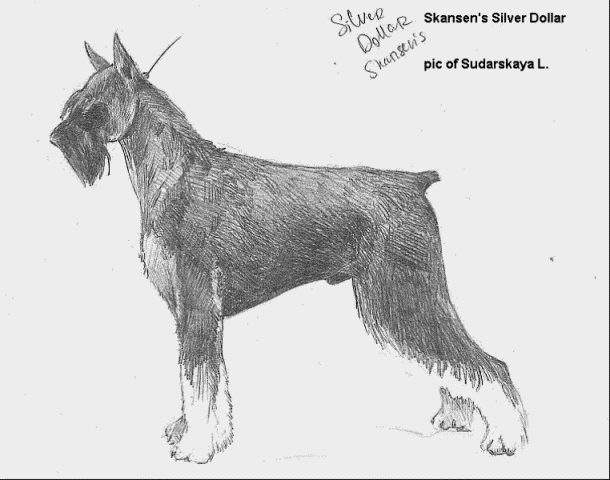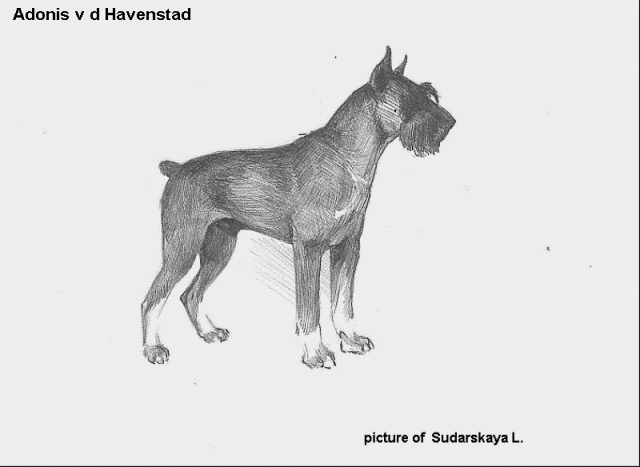THE PEPPER AND SALT GIANT SCHNAUZER
The Pepper & Salt Giant Schnauzer
By Javier Sanchez
(This article was written for the Spanish Magazine “La Revista del Perro” 1995, and translated for the English Magazine “Giant Jottings” by Maria Gonzales.)
Javier Sanchez is an International Judge Specialist in Schnauzers and breeder of Giants since the late seventies under the prefix “Barba Negra.”
(Sanchez’ article below entitled “Recent History and the Current Situation” contains updated information.)

All three Schnauzer varieties originate from the pepper and salt Standard, this serving as point of reference in the creation of the three sizes and four different colors recognized today by the canine authorities. The change in fashion, based mainly on esthetic issues, is the factor that has the greatest effect on the development of many good dog breeds. The use in the past of the black German Dane in the creation of the Giant Schnauzer produced very dominate results as regards to genotype and in only a few years, the black color was largely spread, overshadowing in its way, the existence of the pepper and salt variety. There were always however, about half a dozen enthusiasts in Europe that carried on breeding pepper and salts, turning their backs on easier and quicker success. Generally speaking, the few breeders of Giant pepper and salts that exist today, have shown great perseverance through the years and achieved extensive technical knowledge. Their objectives have never included commercial breeding but the maintenance of the original bloodlines and characteristics of the breed. The author of this article finds himself in this position an welcomes the fact that the pepper and salt Giant Schnauzer
is a very exclusive breed in the hands of a minority of enthusiasts and true experts. Mostly all combinations of colors can be found in many breeds, i.e., black and tan (Manchester Terrier, Dobes, Gordon Setters, etc.) or brindle (Boxer, Great Danes, Greyhounds, etc.) However, the pepper and salt color is unique and exclusive to the Schnauzer breeds. But color is not the only issue that distinguishes the pepper and salt from the black Giants.
The pepper and salt variety has experienced a slower development through the years than a black one due to its lack of popularity and therefore, small numbers. Breeders have always endeavored to keep the purity of the color though this means and other breeds cannot be used in the development, no matter how similar these are. The pepper and salt dogs look more rustic and their lines are not refined and clean. Their temperament is also slightly different and closer to the original Schnauzers, i.e., they are more wary of strangers (making them good guard dogs) and more devoted to and dependent of their owners than most of the black specimens. Many judges who encounter this variety for the first time make the inevitable mistake of comparing them with the black Schnauzers, but only true connoisseurs of this breed are able to judge it with the justice and independence that it requires. The FCI forbids the cross between pepper and salt and black Schnauzers and these compete separately at shows. Therefore, I think that the breed standard should reflect the differences affecting the pepper and salt.

The American Option
Great Britain and the United States do not belong to the FCI and both countries allow inter-breeding of pepper and salt and black specimens. This means that after two or three generations impure colors like off-black, lead-gray, and other undesirable shades of gray will be produced. Pure pepper and salt color can eventually be brought back if these individuals are mated to a pepper and salt dog but it is probable that the color will begin to darken when the animal reaches two or three years of age. To all these risks we must add the fact that the American bred dogs differ from the classic and traditional European Schnauzer, the latter having better head/body proportion, shorter back and harsher coat. It is however, an interesting option and Sylvia Hammarstrom of the Skansen prefix is the top breeder in the Sates partly thanks to her collaboration with Belgium breeder Cyril de Meulenaer.

Recent History and the Current Situation
Dogs like Ch. Roland Rolandsheim (1910) and Ch. Bill V. Hochland (1929) were very influential with regards to type and color. German breeder Elsa Wettlaufer of the Von Widderhof prefix played a major role in the development of the breed during the late fifties and some of her dogs like Ch. Boy V. Widderhof are still remembered nowadays. Unfortunately, the type in today’s German specimens has deteriorated considerably mainly because breeders have endeavored to create functional dogs only by selecting temperament and controlling hip dysplasia. These certainly are important factors to take into account but are not incompatible with type and physical harmony. France has some interesting dogs. In the last few years, Delphine Colin has produced and exported several specimens to Finland, Russia, Australia, and the United States under the prefix “Des Hauts De Longuante”. These Giants will have an excellent influence in breeding in the next years as well as the dogs of my two litters of the last four years. Holland is an interesting country with breeders like Fred Aerts-v Rijn or Alexandra van den Honert, though they have started using American lines. Croatian breeder Darco Popovic told me recently that he is not planning to breed anything in the next few years as he cannot find any lines that interest him. Cyril de Meulenaer of the Van De Havenstad prefix is now retired from Giants and has dedicated the last few years to Miniatures. He produced some extraordinary dogs like Faust v.d Havenstad and Adonis v.d. Havenstad and these appear in most pedigrees. Some of his dogs were exported to the U.K. and the States.
